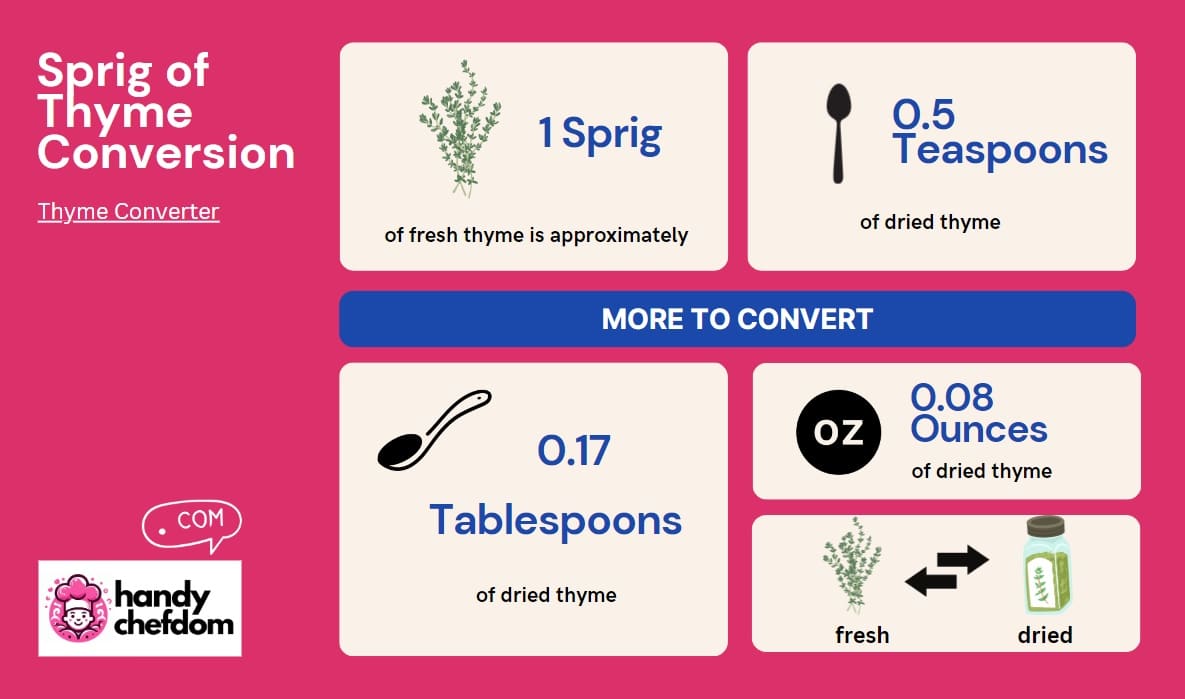Fresh to Dried Thyme Converter
Purpose of Thyme Converter
Have you ever found yourself wondering how much dried or fresh thyme you need when your recipe only gives instructions for the opposite of what you’ve got in your kitchen?
Use our sprig of thyme converter to work out the perfect amount for delicious, well-balanced meals time and time again no matter what your ingredient list asks for.
Sprig of Thyme Measurement Types
Our sprig of thyme converter lets you convert between all the common thyme measurements you can expect to find online and in cookbooks which are the following.
Fresh Thyme: Sprig, Teaspoon, Tablespoon, Ounce, Cup
Dried Thyme: Teaspoon, Tablespoon, Ounce, Cup

Fresh To Dried Converter – Thyme
How Much is 1 Sprig of Thyme to Dried in Teaspoons?
- 0.5 Teaspoons of Dried Thyme
How Much is 1 Sprig of Thyme to Dried in Tablespoons?
- 0.17 Tablespoons of Dried Thyme
How Much is 1 Sprig of Thyme to Dried in Ounces?
- 0.08 Ounces of Dried Thyme
How Much is 1 Sprig of Thyme to Dried in Cups?
- 0.01 Cups of Dried Thyme
Dried To Fresh Converter – Thyme
How Much is 1 Teaspoon of Dried Thyme to Fresh in Sprigs?
- 2 Sprigs of Fresh Thyme
How Much is 1 Teaspoon of Dried Thyme to Fresh in Tablespoons?
- 0.33 Tablespoons of Fresh Thyme Sprigs
How Much is 1 Teaspoon of Dried Thyme to Fresh in Ounces?
- 0.17 Ounces of Fresh Thyme Sprigs
How Much is 1 Teaspoon of Dried Thyme to Fresh in Cups?
- 0.02 Cups of Fresh Thyme Sprigs
What Does A Sprig Of Thyme Look Like – How Much?
A sprig of thyme looks like a bendy stem, about the same thickness as a nylon cord, that twists and curves similar to a short vine with many offshoots sprouting tiny, teardrop-shaped leaves.
Sprigs come in different sizes and you actually call each individual offshoot a sprig by itself.
A standard sprig as listed by most recipes and harvested just before flowering for best flavor is roughly the size of a small pocket knife, or about five inches long.
Sprigs are often much smaller but this is the regular size.
Most dishes call for nothing more than one to two sprigs of fresh thyme unless you’re cooking big volumes of food.
This works out to far less than you’d at-first expect when using dried thyme thanks to just how concentrated it is.
There are exceptions like rubs and stocks that are especially herb-heavy, but you generally don’t use much at once.
Do You Use The Whole Sprig Of Thyme?
You can use a whole sprig of thyme in whatever you’re cooking up but it’s much better for the mouthfeel of your food to remove the center stem at some point.
If you’re looking for the strongest taste of thyme possible, put your sprigs in whole then gently remove the leaves and throw away the stems after cooking, and before serving.
Put in only the biggest sprigs to make taking them out easy.
Otherwise, you can avoid the issue of stalky stems and hard bits in your food entirely by pulling off the thyme leaves and adding them alone.
Keep in mind, the taste will be much lighter. If you want to skip over taking them out completely but still want more flavor, chop up only the tenderest, tiniest top section of each sprig.
Is A Sprig Of Thyme One Branch?
Yes, one twig, big or small, from a thyme shrub of any variety is a sprig.
You also consider every separate offshoot and its leaves, or the branches of each branch, sprigs individually.
The branches of all herbs are called sprigs no matter how thin or wiry, or thick and woody they may be.
However, in cooking terms, when a recipe or person tells you to use a sprig of thyme, this is the main spirally cutting that holds all of the many leaf and bud sites.
The Best Thyme Substitutes
The go-to substitute for thyme for anyone who doesn’t want to mess with the base flavor of whatever they’re preparing should be marjoram.
Its prevailing mildness, sweetness and depth come close to a cross between thyme and oregano, which is our next recommendation.
Oregano is woodier with a more intense herb-forward flavor, but add an equal amount of it to your food during the last few minutes of cooking, and it’ll come together just right without bitterness to resemble thyme.
Savory is another great swap-out that’s not as sweet and greener in taste, but otherwise an almost identical match in every other way.